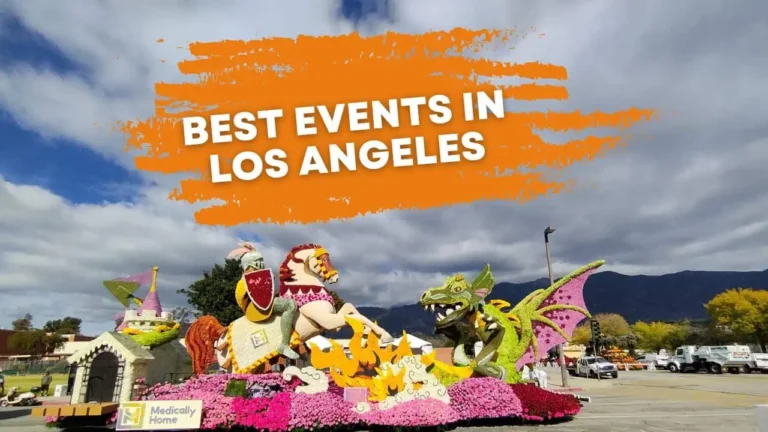15 Best Things to Do in Everglades National Park – Entry Fee, Hiking Trails, Map, Activities, Camping, and Airboat Tours
Everglades National Park is one of the most unique and fascinating places in the United States. It is home to a vast array of wildlife, including endangered species like the Florida panther, the leatherback turtle, and the American crocodile. In this article, we will share with you some of the best things to do in Everglades National Park, from the most popular attractions to the hidden gems. We will also give you some tips on how to plan your visit, what to pack, and where to stay.

If you are looking for an adventure in nature, the Everglades has plenty to offer. You can explore the park by foot, bike, kayak, canoe, airboat, or tram, and discover the diverse habitats and landscapes that make up this amazing wilderness. Whether you want to see alligators and manatees, hike through cypress swamps and mangroves, or enjoy the scenic views of Florida Bay and the Ten Thousand Islands, there is something for everyone in the Everglades.
So get ready for an unforgettable experience in one of the most beautiful and diverse national parks in the country!
Consider reading: Top 10 National Parks in the USA
List of 15 Best Things to Do in Everglades National Park
| Activity | Description |
|---|---|
| Airboat Tours | Everglades Safari Park, located just outside the park’s boundaries, offers airboat tours and wildlife shows. |
| Geocaching | Geocaching is allowed in designated areas of the park, but caches must be registered with the park and some areas may be off-limits due to conservation concerns. |
| Hiking | The park has several hiking trails, including the Anhinga Trail, which offers excellent opportunities to view wildlife such as alligators and wading birds. Other trails include the Mahogany Hammock Trail and the Gumbo Limbo Trail. |
| Wildlife Watching | The park is home to a diverse array of wildlife, including alligators, manatees, and many species of birds. Visitors can view wildlife from hiking trails, observation towers, or on ranger-led programs. |
| Ranger-led Programs | The park offers a variety of ranger-led programs, including guided hikes, campfire programs, and talks on topics such as ecology and conservation. Programs are held at various locations throughout the park and are a great way to learn more about the park’s history and natural features. |
| Camping | Backcountry camping is available in the park with a permit. The park also has frontcountry camping at Long Pine Key Campground and Flamingo Campground. |
| Boating | Visitors can rent boats and fishing gear at Flamingo Marina, located at the southern end of the park. The marina also offers guided boat tours. |
| Visitor Centers | The park has two visitor centers, the Ernest F. Coe Visitor Center at the northern end of the park and the Flamingo Visitor Center at the southern end. Both offer a variety of services, including camping permits, backcountry permits, and ranger-led programs. |
| Observation Towers | The Shark Valley Observation Tower is a 45-foot observation tower that offers panoramic views of the park. The tower is located along the park’s 15-mile Shark Valley Trail and is accessible by foot, bike, or tram tour. |
| Kayaking/Canoeing | Visitors can explore the park’s waterways by renting kayaks or canoes or joining a guided tour. The park has several paddling trails, including the 99-mile Wilderness Waterway. |
| Fishing | Fishing is allowed in certain areas of the park, but visitors must have a Florida fishing license and follow park regulations. |
| Biking | Visitors can explore the park by bike on designated bike trails or on park roads. |
| Picnicking | The park has several picnic areas, including at Flamingo, Long Pine Key, and Royal Palm. |
| Stargazing | The park’s remote location and lack of light pollution make it an excellent place for stargazing. Visitors can enjoy the night sky on their own or on ranger-led astronomy programs. |
| Photography | The park’s diverse landscapes and wildlife provide ample opportunities for photography. Visitors should be respectful of wildlife and take care to minimize their impact on the park’s fragile ecosystem. |
Everglades National Park Key Details
| Location | Southern Florida, United States |
| Area | 1.5 million acres |
| Established | 1934 |
| Designation | National park |
| Ecosystem | Wetlands |
| Wildlife | Alligators, crocodiles, panthers, manatees, dolphins, turtles, snakes, and a variety of bird species |
| Activities | Hiking, camping, boating, kayaking, canoeing, fishing, and wildlife viewing |
| Popular Hiking Trails | Anhinga Trail, Shark Valley Trail, Gumbo Limbo Trail |
| Visitor Centers | Ernest F. Coe Visitor Center, Flamingo Visitor Center |
| Entrance Fee | $30 per vehicle, $25 per motorcycle, $15 per person for Paddle-craft, pedestrians or cyclists (valid for 7 days) |
| Commercial Tour Entry Fee | Motorcoach (26 or more passengers): $200.00 Minibus (16 – 25 passengers): $100.00 Van (7 – 15 passengers): $75.00 Sedan (1-6 passengers): $25.00 plus $15 per client |
| Weather | Hot and humid with frequent rainstorms |
| Best Time to Visit | December to April (cooler, drier months) |
| Important Note | Stay on designated trails and be aware of potential wildlife encounters. |
Everglades National Park Hiking Trails
Everglades National Park is a beautiful destination that has plenty of outdoor activities to offer. One of the most exciting activities is hiking, which is a great way to explore the park’s diverse landscape.
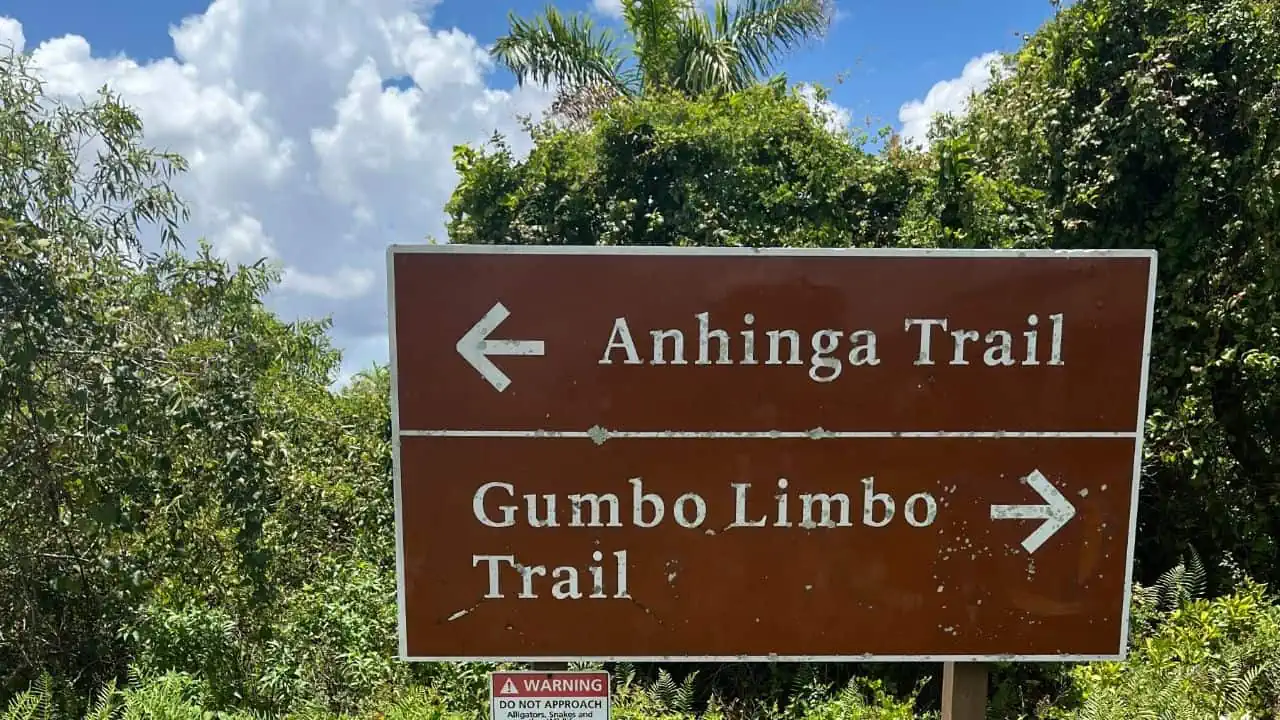
Even though the park is mostly known for its water-based activities, there are several hiking trails worth checking out.
Here are a few well-known Everglades National Park hiking trails:
| Trail Name | Distance | Terrain | Difficulty Level | Highlights |
|---|---|---|---|---|
| Anhinga Trail | 0.8 miles (roundtrip) | Boardwalk | Easy | Alligator and bird sightings, sawgrass marsh |
| Shark Valley Trail | 15 miles (loop) | Paved and gravel | Moderate | Panoramic views, observation towers, sawgrass prairies and hardwood hammocks |
| Gumbo Limbo Trail | 0.4 miles (loop) | Boardwalk | Easy | Hardwood hammock, gumbo limbo tree |
| Pinelands Trail | 0.4 miles (loop) | Sandy soil | Easy | Pine rockland habitat, birdwatching |
| Snake Bight Trail | 1.6 miles (roundtrip) | Boardwalk and dirt | Moderate | Scenic views of Florida Bay, wildlife sightings |
| Coastal Prairie Trail | 0.5 miles (roundtrip) | Boardwalk | Easy | Coastal prairie habitat, birdwatching |
| Christian Point Trail | 1.5 miles (roundtrip) | Boardwalk | Easy | Coastal views, birdwatching |
| Old Ingraham Highway Trail | 6.2 miles (roundtrip) | Paved | Easy | Historic trail, scenic views, birdwatching |
| Flamingo Trails System | Various | Boardwalk, dirt, and pavement | Easy to moderate | Mangrove forest, bay views, birdwatching |
Note: Always check trail conditions and weather forecasts before hiking. Stay on designated trails and be aware of potential wildlife encounters. Carry plenty of water, sunscreen, and insect repellent.
Consider reading: 17 Best Hikes in the Everglades National Park
Explore the Wonders of Everglades National Park on These Must-See Hiking Trails
Everglades National Park, a haven for nature enthusiasts and adventure seekers, offers a variety of hiking trails that cater to all levels of experience. Whether you’re an avid hiker or a casual explorer, these trails provide an intimate encounter with the park’s diverse ecosystems and wildlife.
- Anhinga Trail: A Wildlife Lover’s Dream
- Length: 0.8 miles
- Type: Boardwalk
- Highlights: Immerse yourself in the lush sawgrass marshes and witness an array of wildlife, including alligators, turtles, and various bird species. This accessible trail is perfect for all ages and offers a unique opportunity to experience the park’s vibrant ecosystem up close.
- Shark Valley Trail: A Panoramic Adventure
- Length: 15 miles
- Type: Loop, suitable for hiking and biking
- Features: Traverse the expansive sawgrass prairies and hardwood hammocks. The trail boasts several observation towers, providing breathtaking panoramic views of the park. It’s an ideal choice for those seeking a longer, more immersive experience in the Everglades.
- Gumbo Limbo Trail: A Quick Escape into Nature
- Length: 0.4 miles
- Type: Loop
- Experience: This shorter trail meanders through a dense hardwood hammock. It’s an excellent way to discover diverse plant and animal life, including the distinctive gumbo limbo tree. Perfect for a brief yet enriching nature walk.
Essential Tips for Hiking in the Everglades:
Hiking in the Everglades National Park can be a challenging yet rewarding experience. To ensure a safe and enjoyable visit:
- Stay Prepared: Equip yourself with water, sunscreen, and insect repellent, especially during the hot, humid summer months.
- Trail Etiquette: Adhere to designated trails to protect the environment and yourself.
- Wildlife Awareness: Be vigilant of your surroundings and respectful of the park’s inhabitants.
Everglades National Park’s hiking trails offer an unparalleled opportunity to explore one of the world’s most unique natural environments. Each trail promises a distinct experience, allowing you to tailor your adventure to your interests and fitness le
Download the Map of the Everglades National Park.
Canoeing and Kayaking at Everglades National Park
Canoeing and kayaking are exciting activities that visitors can enjoy at Everglades National Park. The park’s unique wetlands and waterways offer an unforgettable experience for paddlers of all skill levels.
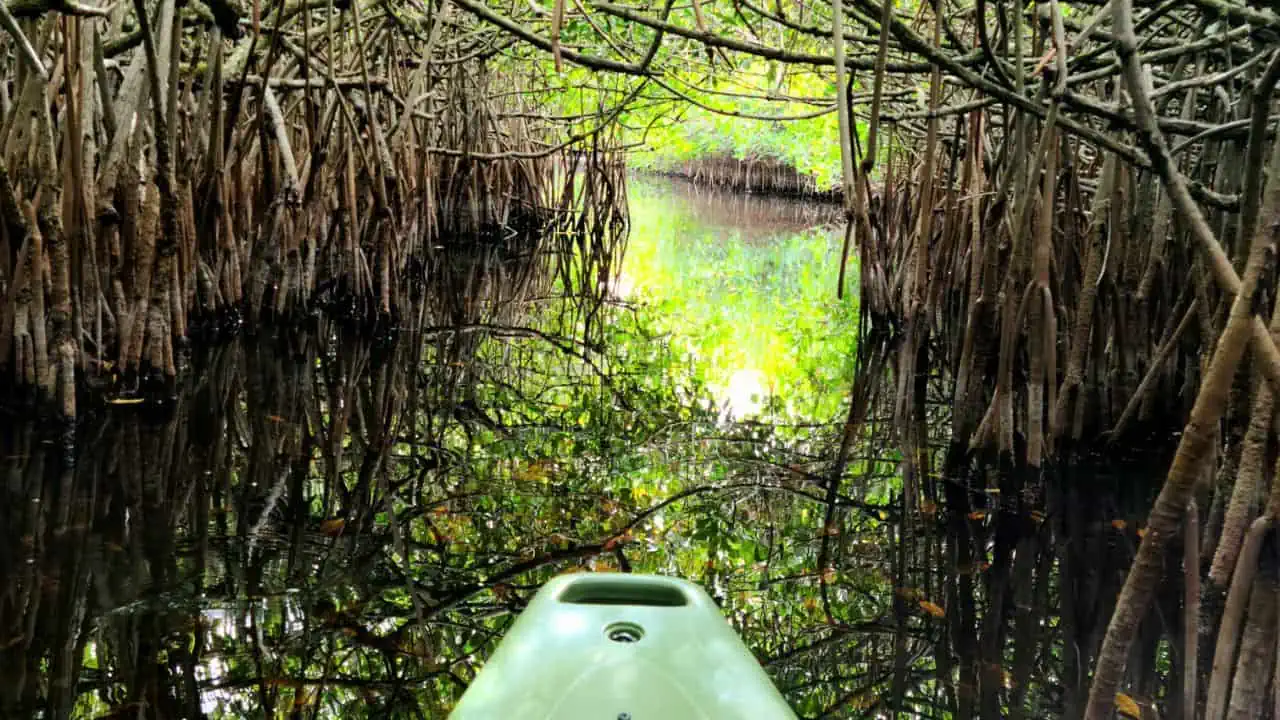
Everglades National Park offers a remarkable paddling experience, with diverse water trails that cater to both novice and experienced paddlers. Each route unfolds a new aspect of the park’s rich ecosystems, providing intimate encounters with its unique wildlife.
- 99-Mile Wilderness Waterway: A Paddler’s Paradise
- Distance: 99 miles
- Highlights: This extensive waterway takes you through the park’s core, offering sightings of manatees, dolphins, and various bird species. Camp at designated sites or stay in the park’s backcountry chickees for a complete wilderness experience.
- Nine Mile Pond Canoe Trail: A Serene Journey
- Distance: 5.5 miles
- Experience: Ideal for a shorter excursion, this trail navigates through a captivating cypress swamp, showcasing the park’s distinctive ecosystem. It’s perfect for those seeking a tranquil paddle amidst nature.
- Ten Thousand Islands Exploration: An Island-Hopping Adventure
- Features: Explore the myriad of islands and shallow bays by kayak or canoe. This journey is an exceptional way to experience the park’s mangrove ecosystem. Overnight campsites are available for a deeper exploration of this unique area.
Paddling Precautions in the Everglades:
Paddling in Everglades National Park can be as challenging as it is rewarding. To ensure a safe and enjoyable adventure:
- Weather and Wildlife: Prepare for variable weather conditions, strong winds, and encounters with local wildlife.
- Safety Gear: Equip yourself with essential gear, including life jackets, paddles, and navigation tools.
- Equipment Rental: Canoe and kayak rentals are available here for those needing equipment.
Canoeing and kayaking in Everglades National Park are immersive ways to explore the park’s picturesque wetlands and waterways. Whether you’re seeking a leisurely paddle or an extended journey, the park offers a variety of routes to cater to different preferences and abilities.
Wildlife Watching at Everglades National Park
Wildlife watching is one of the most popular things to do at Everglades National Park.
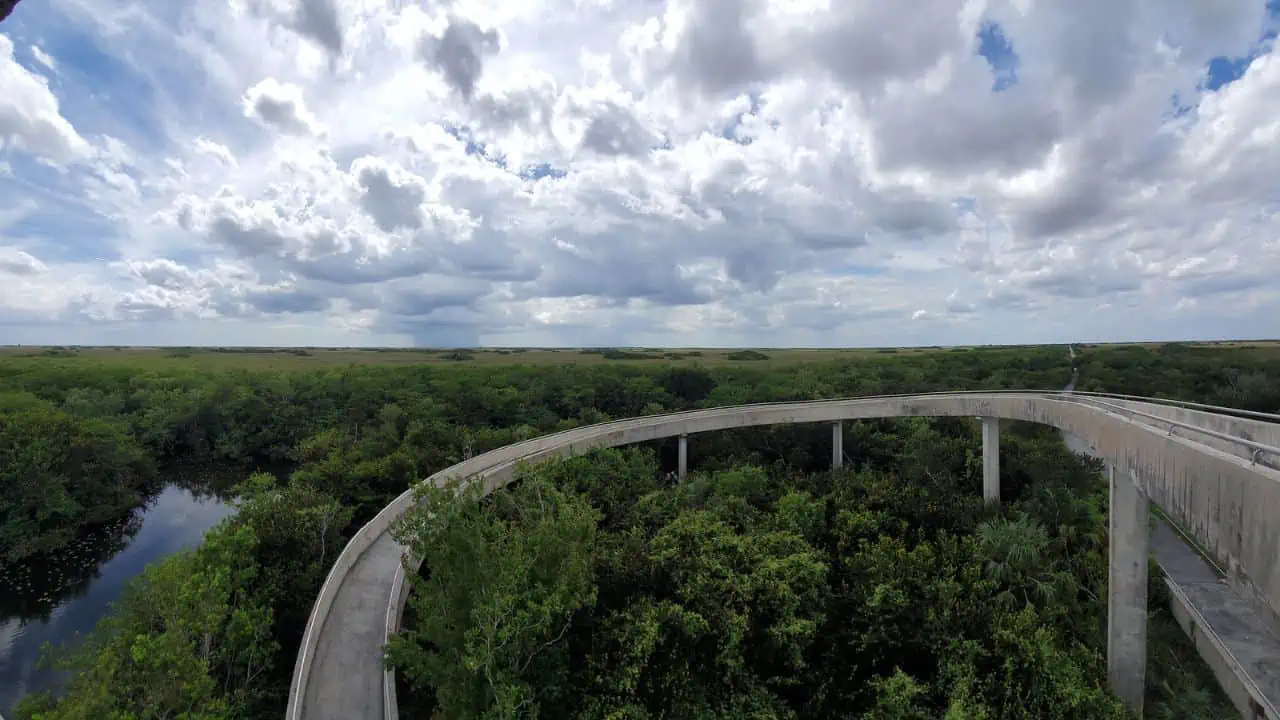
With over 1.5 million acres of wetlands, the park is home to a diverse range of wildlife, including alligators, crocodiles, panthers, manatees, dolphins, turtles, and a variety of bird species.
Here are some tips for wildlife watching at Everglades National Park:
- Know where to look – Different wildlife species can be found in different areas of the park, so it’s important to do your research and find out where to look for the animals you want to see. The Anhinga Trail and Shark Valley Trail are popular spots for birdwatching and alligator sightings.
- Be patient – Wildlife watching can require patience and perseverance. Be prepared to spend some time waiting and observing quietly to increase your chances of spotting animals.
- Use binoculars – Binoculars can be a useful tool for wildlife watching, allowing you to observe animals from a safe distance without disturbing them.
- Respect wildlife and their habitat – It’s important to remember that you are a visitor in the animals’ home. Keep a safe distance, stay on designated trails, and avoid disturbing wildlife and their habitat.
- Be aware of potential hazards – Wildlife encounters can be unpredictable, and it’s important to be aware of potential hazards, such as alligator attacks or snake bites. Always keep a safe distance and follow park guidelines to avoid dangerous situations.
In summary, wildlife watching is a popular activity at Everglades National Park, offering visitors a chance to see a diverse range of animals in their natural habitat.
Camping at Everglades National Park
Camping is a popular thing to do at Everglades National Park, offering visitors a unique way to experience the park’s natural beauty and wildlife.
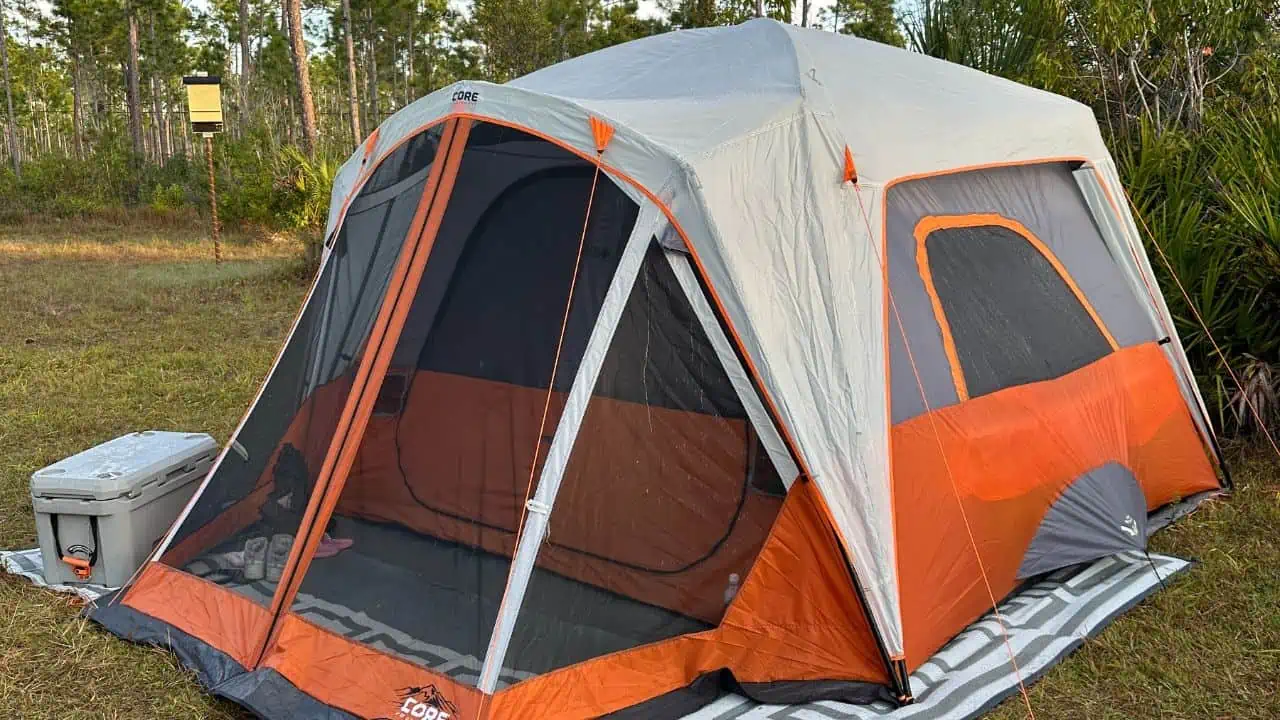
With several campgrounds to choose from, visitors can customize their camping experience to suit their interests and needs.
Here’s what you need to know about camping at Everglades National Park:
- Campgrounds – The park has three campgrounds: Long Pine Key Campground, Flamingo Campground, and the backcountry campsites. Long Pine Key and Flamingo Campgrounds are managed by the National Park Service and offer amenities such as restrooms, showers, and picnic tables. Backcountry campsites are located throughout the park and require permits for overnight stays.
- Reservations – Reservations are recommended for Long Pine Key and Flamingo Campgrounds, especially during peak season (December to April). Reservations can be made up to six months in advance through the National Park Service website or by calling 1-877-444-6777.
- Fees – Fees for camping vary depending on the campground and type of site. Long Pine Key and Flamingo Campgrounds have a nightly fee of $30 per site, while backcountry camping permits start at $10 per person per night.
- Equipment – Visitors are responsible for bringing their own camping equipment, including tents, sleeping bags, and cooking supplies. Some equipment can be rented at the park’s visitor centers or through local outfitters.
- Safety – It’s essential to follow park guidelines and safety rules while camping, especially when it comes to wildlife encounters. Follow food storage guidelines, keep a safe distance from animals, and be aware of potential hazards such as weather conditions.
Camping Price at Everglades National Park
| Camping Site – Flamingo Campground | Days | Fee (General) | Fee (Senior/Military/Access) |
|---|---|---|---|
| RV with Electric Hook-Up | Mon-Thu | $45.00 | $40.50 |
| RV with Electric Hook-Up | Fri-Sun | $55.00 | $49.50 |
| Tent and Non-Electric RV | Mon-Thu | $30.00 | $27.00 |
| Tent and Non-Electric RV | Fri-Sun | $35.00 | $31.50 |
| Group Site | Per Night | $55.00 | N/A |
Note: The fees mentioned here are per site per night and cover the cost of electric and non-electric hook-ups. The camping fee does not include the entrance fee to the park. The group site fee covers up to 15 people, 5 tents, and 3 vehicles per night.
Consider reading: Camping Packing List – 31 Essential items, Accessories and Gears
In summary, camping at Everglades National Park is a unique and enjoyable way to experience the park’s natural beauty and wildlife. With several campgrounds to choose from, visitors can customize their camping experience to suit their interests and needs.
Remember to follow park guidelines and safety rules to ensure a safe and enjoyable camping experience.
Fishing at Everglades National Park
Fishing is a popular activity at Everglades National Park, offering visitors an opportunity to catch a wide variety of fish species in the park’s diverse wetlands and waterways. Here’s what you need to know about fishing at Everglades National Park:
- Regulations – Fishing regulations in the park are designed to protect the park’s ecosystem and ensure sustainable fishing practices. Visitors should be aware of the park’s fishing regulations and obtain a Florida fishing license before fishing in the park.
- Fish Species – The park is home to a diverse range of fish species, including snook, tarpon, redfish, sea trout, and many more. Some species are catch-and-release only, so visitors should be familiar with the park’s regulations before fishing.
- Equipment – Visitors are responsible for bringing their own fishing equipment, including rods, reels, and bait. Some equipment can be rented at the park’s visitor centers or through local outfitters.
- Safety – It’s important to follow park guidelines and safety rules while fishing, especially when it comes to wildlife encounters. Keep a safe distance from animals, and be aware of potential hazards such as weather conditions.
- Best Time to Fish – The best time to fish in Everglades National Park is during the winter months, from December to April. During this time, the water is cooler, and many fish species are more active.
In summary, fishing is a popular activity at Everglades National Park, offering visitors a chance to catch a wide variety of fish species in the park’s diverse wetlands and waterways.
Ranger-led Programs at Everglades National Park
Everglades National Park offers a variety of ranger-led programs that provide visitors with a chance to learn more about the park’s unique ecosystem, wildlife, and cultural history. Here’s what you need to know about ranger-led programs at Everglades National Park:
- Programs – The park offers a variety of ranger-led programs, including guided hikes, bike tours, boat tours, and evening programs. These programs are designed to educate visitors about the park’s ecosystem, wildlife, and cultural history.
- Schedule – Ranger-led programs are offered seasonally, and schedules can be obtained at the park’s visitor centers or online. Some programs require reservations, so it’s important to check ahead of time.
- Fees – Most ranger-led programs are free, but some programs may have a fee or require a donation to participate.
- Accessibility – The park strives to make ranger-led programs accessible to all visitors, regardless of their abilities. Some programs are wheelchair accessible, and assistive listening devices are available for some programs.
- Safety – Visitors should follow park guidelines and safety rules while participating in ranger-led programs, especially when it comes to wildlife encounters. Keep a safe distance from animals and be aware of potential hazards such as weather conditions.
In summary, ranger-led programs are an excellent way to learn more about Everglades National Park’s unique ecosystem, wildlife, and cultural history.
Airboat Tours at Everglades National Park
Airboat tours are a popular activity in Everglades National Park, offering visitors a unique way to explore the park’s wetlands and see a variety of wildlife.
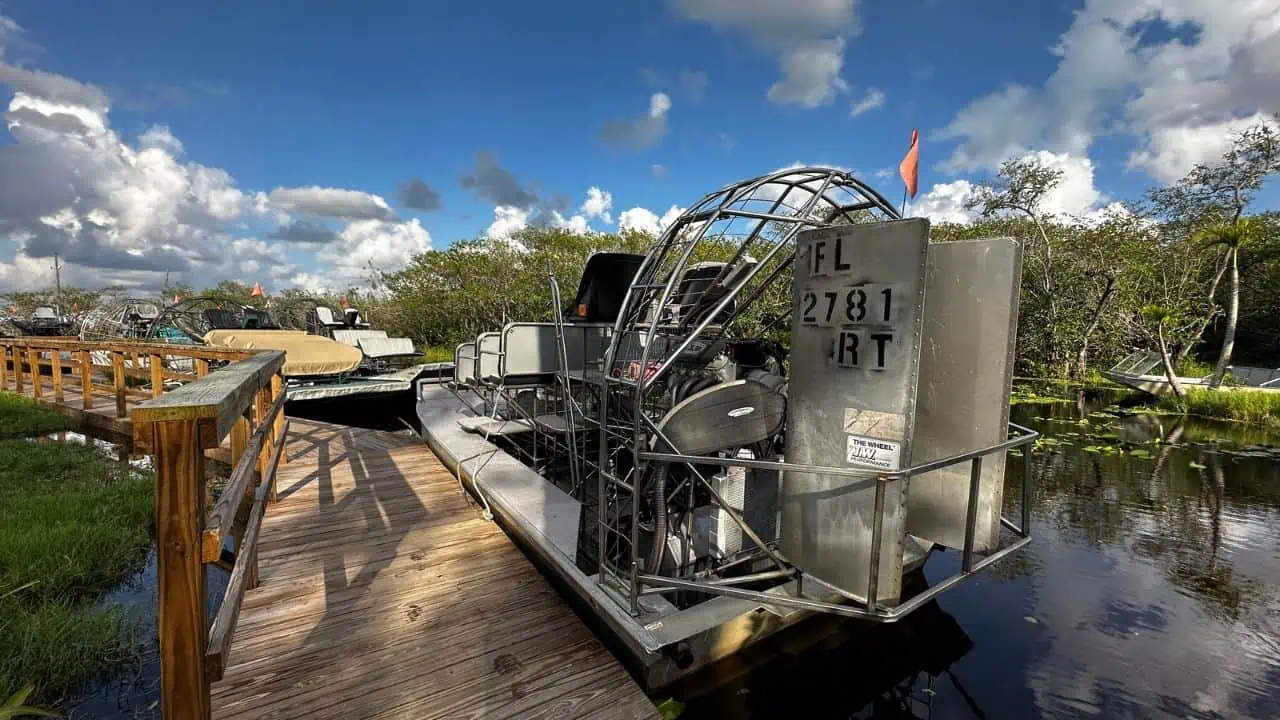
Here’s what you need to know about airboat tours at Everglades National Park:
- Tours – Airboat tours are offered by several private companies that operate within the park. These tours typically last between 30 minutes to one hour and provide visitors with an up-close look at the park’s unique ecosystem, including alligator sightings and birdwatching.
- Fees – Fees for airboat tours vary depending on the company and length of the tour. Visitors should check with the tour operator for specific pricing.
- Safety – Visitors should follow safety guidelines provided by the tour operator, such as wearing ear protection and staying seated during the tour. It’s also important to be aware of potential hazards, such as alligator encounters.
- Ecological Impact – Airboat tours can have ecological impacts on the wetlands and wildlife. Visitors should choose an airboat tour operator that follows responsible and sustainable tourism practices.
- Accessibility – Airboat tours may not be accessible to all visitors, especially those with mobility issues. Visitors should check with the tour operator for accessibility information.
In summary, airboat tours are a popular way to explore Everglades National Park’s wetlands and see a variety of wildlife.
Biking at Everglades National Park
Biking is a great way to explore Everglades National Park, offering visitors a chance to see the park’s unique ecosystem and wildlife while enjoying the fresh air and exercise.
Here’s what you need to know about biking at Everglades National Park:
- Trails – The park offers several trails for biking, including Shark Valley Trail, which is a 15-mile loop that takes visitors through sawgrass prairies and hardwood hammocks. Another popular option is the Old Ingraham Highway Trail, which is a 6.2-mile round trip that offers scenic views and birdwatching opportunities.
- Rentals – Visitors can rent bikes from the Shark Valley Visitor Center and the Flamingo Visitor Center. Rentals are available on a first-come, first-served basis, and fees vary depending on the length of the rental.
- Safety – Visitors should follow park guidelines and safety rules while biking, including wearing a helmet, staying on designated trails, and being aware of potential hazards such as wildlife encounters.
- Accessibility – Biking may not be accessible to all visitors, especially those with mobility issues. Visitors should check with the park for accessibility information.
- Weather – It’s important to be aware of the weather conditions while biking in the park. The summer months can be hot and humid, while the winter months can be cooler and more comfortable.
In summary, biking is a fun and enjoyable way to explore Everglades National Park’s unique ecosystem and wildlife.
Photography at Everglades National Park
Photography is a popular activity at Everglades National Park, offering visitors a chance to capture the park’s stunning natural beauty and unique wildlife.
Here’s what you need to know about photography at Everglades National Park:
- Equipment – Visitors are responsible for bringing their own photography equipment, including cameras, lenses, and tripods. Some photography equipment can be rented at the park’s visitor centers or through local outfitters.
- Best Time to Photograph – The best time to photograph in Everglades National Park is during the winter months when the weather is cooler, and many wildlife species are more active. Sunrise and sunset are also excellent times for photography, offering beautiful lighting and dramatic colors.
- Wildlife Photography – Visitors should be respectful of the park’s wildlife and follow park guidelines and safety rules while photographing animals. Keep a safe distance and avoid disturbing the animals or their habitat.
- Landscape Photography – The park offers a variety of stunning landscapes to photograph, including wetlands, prairies, and hardwood hammocks. Visitors should be aware of potential hazards, such as weather conditions and uneven terrain, while exploring the park’s landscapes.
- Photo Workshops – The park offers several photography workshops throughout the year, providing visitors with an opportunity to learn from experienced photographers and improve their photography skills.
In summary, photography is an excellent way to capture Everglades National Park’s unique beauty and wildlife.
Junior Ranger Program at Everglades National Park
The Junior Ranger Program is a fun and educational activity for kids at Everglades National Park. The program offers kids a chance to learn about the park’s ecosystem, wildlife, and cultural history while earning a Junior Ranger badge.
Here’s what you need to know about the Junior Ranger Program at Everglades National Park:
- Requirements – To become a Junior Ranger, kids must complete a series of activities, including attending a ranger-led program, exploring the park’s trails, and completing a Junior Ranger booklet.
- Booklets – Junior Ranger booklets are available at the park’s visitor centers or can be downloaded online. The booklet includes activities that teach kids about the park’s ecosystem, wildlife, and cultural history.
- Badge – Kids who complete the Junior Ranger program can earn a Junior Ranger badge and certificate.
- Age Range – The Junior Ranger Program is designed for kids between the ages of 5 and 12.
- Cost – The Junior Ranger Program is free, and there is no cost to participate.
In summary, the Junior Ranger Program is a fun and educational activity for kids at Everglades National Park. By completing a series of activities, kids can learn about the park’s ecosystem, wildlife, and cultural history while earning a Junior Ranger badge. The program is free and available to kids between the ages of 5 and 12.
Geocaching at Everglades National Park
Geocaching is a popular activity at Everglades National Park, offering visitors a fun and interactive way to explore the park’s natural beauty and landmarks.
Here’s what you need to know about geocaching at Everglades National Park:
- Geocaches – Geocaches are hidden containers that can be found using GPS coordinates. The park has several geocaches hidden throughout the park, offering visitors a chance to explore different areas and landmarks.
- Guidelines – Visitors must follow park guidelines and safety rules while geocaching, including staying on designated trails and avoiding disturbing wildlife or their habitat. Visitors should also be aware of potential hazards, such as weather conditions and uneven terrain.
- Equipment – Visitors will need a GPS device or smartphone with GPS capabilities to participate in geocaching. Some geocaching equipment can be rented at the park’s visitor centers or through local outfitters.
- Geocache Registration – Visitors should register their geocache finds on the park’s geocaching website to help the park monitor geocaching activity and ensure compliance with park regulations.
- Accessibility – Geocaching may not be accessible to all visitors, especially those with mobility issues. Visitors should check with the park for accessibility information.
Geocaching is a fun and interactive way to explore Everglades National Park’s natural beauty and landmarks.
Everglades Safari Park at Everglades National Park
Everglades Safari Park is a popular attraction located near Everglades National Park, offering visitors a chance to explore the park’s wetlands and wildlife on airboat tours and wildlife shows.
Here’s what you need to know about Everglades Safari Park:
- Airboat Tours – Everglades Safari Park offers airboat tours that take visitors through the park’s wetlands, offering views of alligators, birds, and other wildlife.
- Wildlife Shows – The park also offers wildlife shows that feature alligators, snakes, and other animals native to the Everglades.
- Tours & Packages – Everglades Safari Park offers a variety of tours and packages, including airboat tours, wildlife shows, and packages that combine both.
- Fees – Fees for tours and packages vary depending on the length and type of tour. Visitors should check with Everglades Safari Park for specific pricing.
- Ecological Impact – Airboat tours can have ecological impacts on the wetlands and wildlife. Visitors should choose a tour operator that follows responsible and sustainable tourism practices.
The Everglades Safari Park is a popular attraction near Everglades National Park, offering visitors a chance to explore the park’s wetlands and wildlife on airboat tours and wildlife shows.
Flamingo Visitor Center at Everglades National Park
The Flamingo Visitor Center is a popular destination located in the southern part of Everglades National Park, offering visitors a chance to learn about the park’s ecosystem and wildlife.
Here’s what you need to know about the Flamingo Visitor Center:
- Exhibits – The visitor center features exhibits that showcase the park’s unique ecosystem, wildlife, and cultural history.
- Information – Visitors can obtain park maps, brochures, and other information from the visitor center. Rangers are available to answer questions and provide guidance.
- Amenities – The visitor center offers restrooms, a gift shop, and a snack bar.
- Tours – Boat tours, kayak tours, and other tours are available from the visitor center, offering visitors a chance to explore the park’s diverse wetlands and wildlife.
- Accessibility – The visitor center is wheelchair accessible, and there are several accessible restrooms and parking spaces nearby.
The Flamingo Visitor Center is a popular destination in Everglades National Park, offering visitors a chance to learn about the park’s unique ecosystem and wildlife. The visitor center offers exhibits, information, amenities, and tours, and is wheelchair accessible.
Ernest F. Coe Visitor Center at Everglades National Park
The Ernest F. Coe Visitor Center is a popular destination located at the entrance of Everglades National Park, offering visitors a chance to learn about the park’s ecosystem and cultural history.
Here’s what you need to know about the Ernest F. Coe Visitor Center:
- Exhibits – The visitor center features exhibits that showcase the park’s unique ecosystem, wildlife, and cultural history.
- Information – Visitors can obtain park maps, brochures, and other information from the visitor center. Rangers are available to answer questions and provide guidance.
- Amenities – The visitor center offers restrooms, a gift shop, and a bookstore.
- Programs – The visitor center offers a variety of programs, including ranger-led talks, walks, and Junior Ranger activities.
- Accessibility – The visitor center is wheelchair accessible, and there are several accessible restrooms and parking spaces nearby.
The Ernest F. Coe Visitor Center is a popular destination at the entrance of Everglades National Park, offering visitors a chance to learn about the park’s ecosystem and cultural history. The visitor center offers exhibits, information, amenities, and programs, and is wheelchair accessible.
Shark Valley Observation Tower at Everglades National Park
The Shark Valley Observation Tower is a popular attraction located in the northern part of Everglades National Park, offering visitors a chance to see panoramic views of the park’s wetlands and wildlife.
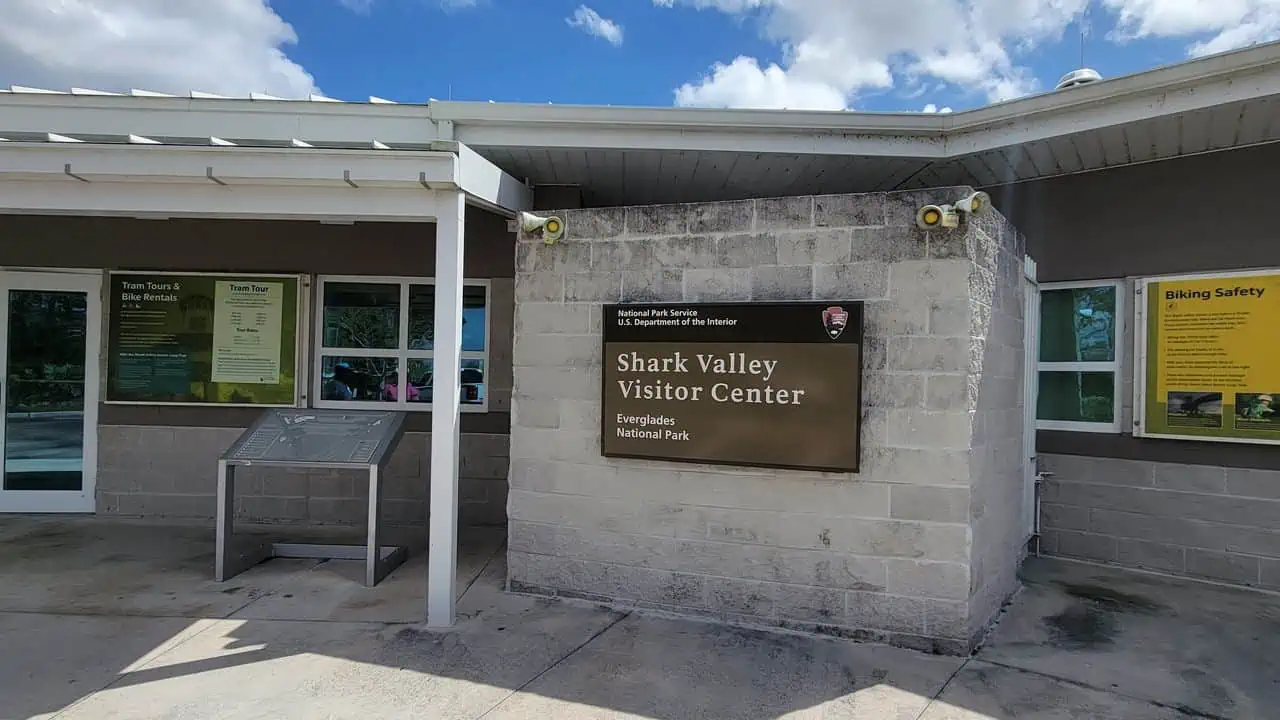
Here’s what you need to know about the Shark Valley Observation Tower:
- Tower – The observation tower is a 45-foot tall structure that offers visitors a 360-degree view of the park’s wetlands and wildlife.
- Trail – Visitors can hike or bike the 15-mile Shark Valley Trail to reach the observation tower. The trail takes visitors through sawgrass prairies and hardwood hammocks.
- Wildlife – The observation tower offers excellent wildlife viewing opportunities, including alligators, turtles, and a variety of bird species.
- Accessibility – The observation tower and trail are wheelchair accessible, and there are several resting areas along the way.
- Best Time to Visit – The best time to visit the observation tower is during the winter months when the weather is cooler, and many wildlife species are more active.
The Shark Valley Observation Tower is a popular attraction in Everglades National Park, offering visitors a chance to see panoramic views of the park’s wetlands and wildlife. Visitors can reach the tower by hiking or biking the Shark Valley Trail, and the tower and trail are wheelchair accessible.
Flamingo Marina at Everglades National Park
Flamingo Marina is a popular attraction located in the southern part of Everglades National Park, offering visitors a chance to explore the park’s diverse wetlands and wildlife.
Here’s what you need to know about Flamingo Marina:
- Activities – Flamingo Marina offers a variety of activities, including boat tours, fishing, kayaking, and hiking.
- Tours – Boat tours are available from the marina, offering visitors a chance to explore the park’s wetlands and see a variety of wildlife, including alligators, dolphins, and manatees.
- Fishing – Flamingo Marina is a popular spot for fishing, offering visitors a chance to catch a variety of fish species, including tarpon, snook, and redfish.
- Rentals – Visitors can rent kayaks, canoes, and fishing equipment from the marina. Rentals are available on a first-come, first-served basis, and fees vary depending on the length of the rental.
- Accessibility – Flamingo Marina may not be accessible to all visitors, especially those with mobility issues. Visitors should check with the park for accessibility information.
The Flamingo Marina is a popular attraction in Everglades National Park, offering visitors a chance to explore the park’s diverse wetlands and wildlife through a variety of activities, including boat tours, fishing, kayaking, and hiking.
Everglades National Park History
Everglades National Park is a unique and important ecosystem located in southern Florida, covering an area of more than 1.5 million acres.
The park is home to a wide variety of plant and animal species and is recognized as a UNESCO World Heritage Site and an International Biosphere Reserve.
Here’s a brief history of how the Everglades National Park came to be:
- Indigenous Peoples: The Everglades region has been home to indigenous peoples for thousands of years, including the Tequesta, Calusa, and Seminole tribes. These people relied on the natural resources of the area for their livelihoods, including fishing, hunting, and farming.
- Drainage and Development: In the late 1800s and early 1900s, developers began draining the Everglades for agricultural and urban development, which caused significant damage to the ecosystem. The construction of roads, canals, and levees also disrupted the natural flow of water in the region.
- Conservation Efforts: In the early 20th century, conservationists began to recognize the importance of the Everglade’s ecosystem and advocated for its preservation. In 1934, Everglades National Park was established to protect the unique natural features of the region.
- Restoration Efforts: In recent decades, efforts have been made to restore the natural flow of water in the Everglades and to mitigate the damage caused by human development. The Comprehensive Everglades Restoration Plan was established in 2000 to address these issues and to ensure the long-term health and sustainability of the ecosystem.
Today, Everglades National Park remains an important symbol of conservation and environmental protection.
The park offers visitors the opportunity to experience the unique beauty and biodiversity of the Everglades and to learn about the ongoing efforts to protect this important ecosystem.
Like to Visit National Parks in the US? Consider reading: 15 Unique Things to Do in Yosemite National Park
Final Thoughts on Best Things to Do in Everglades National Park
As I reflect on my time in Everglades National Park, I can’t help but feel a sense of wonder and awe at the natural beauty that surrounds us. From the stunning wildlife to the serene landscapes, this park truly has something for everyone.
As you plan your visit, be sure to explore the park’s many attractions, including the Anhinga Trail, Flamingo Marina, Ernest F. Coe Visitor Center, Shark Valley Observation Tower, and more. And don’t forget to take advantage of the park’s many camping options, from RV sites with electric hook-ups to group sites.
So don’t hesitate, grab your hiking boots, your camera, and your sense of adventure, and come explore all the best things to do in Everglades National Park. Trust me, it’s an experience you won’t soon forget!
FAQs on Best Things to Do in Everglades National Park
Is Everglades National Park worth visiting?
Absolutely, Everglades National Park is a must-visit! With its rich array of wildlife, including manatees, bald eagles, and numerous bird species, the park offers a unique glimpse into pristine natural beauty. Visitors often rave about the unforgettable boat tours from the Flamingo Visitors Center, making it a highlight for any nature enthusiast.
Is it free to go to the Everglades National Park?
Everglades National Park does charge an entrance fee for all visitors. To streamline your visit, you can purchase digital passes online prior to your arrival. Exploring the park is not free, but the experience is well-worth the cost.
How much does it cost to drive through Everglades National Park?
To drive through Everglades National Park, the vehicle entrance fee is $30, valid for 7 consecutive days. This pass provides access to all park roads and is the most cost-effective option for exploring the area by car. Remember to purchase it in advance or upon arrival.




